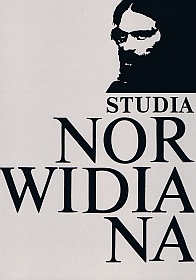Norwid’s Indian episodes. A reconnaissance
Abstract
The article tries to indicate the traces of Norwid's interest in the culture of India. From the writings left by the poet it appears that India was not the main subject of his research. A chapter of the unfinished treatise Sztuka w obliczu dziejów (Art in the Face of History) (1850) is an exception here; Norwid devoted a fragment of the work to Indian art. From the fragment it appears that the author of Quidam had sufficient knowledge about India to formulate critical opinions concerning old caste laws interpreted in terms of Norwid's conceptions of art-work and of the dogma. Also, in Notatki z mitologii (Notes on Mythology) there are sporadic, laconic remarks containing information about Indian art. The notes that are apparently out of context form a certain logical whole polarizing Norwid's views and systematizing his knowledge about the country on the Ganges, or about Orient in general. Certainly one may not speak about complete knowledge here, but the remarks noted by the poet are the essence of a particular problem Norwid knew more or less about. They are: Indian art and architecture, the crisis of art in the face of the schism, the caste system, old-Indian authoritative literature, the Hindu tradition and the Buddhist movement. Norwid's knowledge of particular works of architecture is proven by Skorowidz (Index), where the most important architectural features of ancient India are mentioned: Ellora, Vishvakarma, Nashik, Jayanti in the province of Aurangabad, Elephanta and Salsette islands, Karla in Khandala, Dhumar and Panch Pandu Shrine in the province of Malwa, the famous “Seven Pagodas” of Mahabalipuram, Siringam and Bhagwati in Tanjore in Ceylon. The author's footnotes reveal a wealth of sources used by Norwid. We find here, among others, references to ancient authors, to the 18th century explorer of India – John Zephanian Holwell, or to the lectures by Max Müller. The notes suggest that he also might have known original fragments of Rigveda. The poet also refers several times to Aranyakas – “Forest Books”, that preceded Upanishads, and his knowledge of the Vedic Hymn to Speech could have influenced the Norwidian theory of free speech
Norwid's Indian episodes, succinctly marked in the notes, reveal another, still not very well known, image of the author of Vade-mecum.
Copyright (c) 2012 Studia Norwidiana

This work is licensed under a Creative Commons Attribution-NonCommercial-NoDerivatives 4.0 International License.





